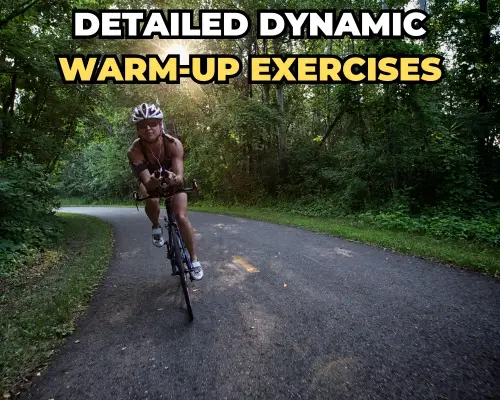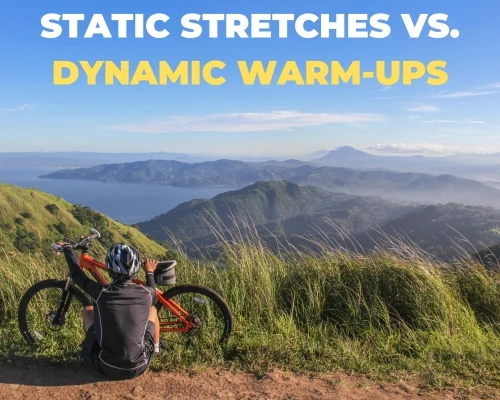Skipping the warm-up before a ride? Think it’s not that crucial? You might want to reconsider. Many riders jump straight onto the saddle. They miss crucial pre-ride routines, often rushing into their cycling session. The result? Stiff muscles and possibly a slower start.
Maybe even injuries. It’s a common oversight, yet easily fixed. Ready to transform your ride with just a few moves? These five dynamic exercises are designed specifically for cyclists. They warm up key muscle groups.
Enhance performance right from the start. And yes, they can prevent those dreaded early-ride cramps. Whether you’re a casual commuter or a serious cyclist, starting right is non-negotiable. Let’s make sure every ride begins on the right pedal.
Cycling Warm Up: 5 Dynamic Exercises To Do
Walking Hamstring Stretch
Think simple stretches are a waste of time? Not so fast. The walking hamstring stretch is a game changer for cyclists. It targets your hamstrings, boosting flexibility and blood flow. This means fewer injuries and better pedal power. Start with feet hip-width apart. Step forward with your left leg, bending at the hips. Reach for the toe of your left foot. Sweep your hand back as you stand. Alternate legs. Aim for 20 steps. Essential for a smooth start to your ride.
Thoracic Rotations
Ever feel stiff on the bike, especially turning to look back? Enter thoracic rotations. This exercise lubricates spinal discs and eases neck movements. Stand with knees slightly bent. Lean forward slightly from the hips. Cross arms over your chest, hands on opposite shoulders. Rotate your upper body to one side, aiming to glance at the sky. Keep your spine neutral. Do 10 twists per side. That’s 20 reps to make your rides smoother.
Lunge With Side Bend and Overhead Reach
Ready to engage your whole lower body before cycling? Try the lunge with side bend and overhead reach. This dynamic move warms up your quads, glutes, ankles, hips, and lower back. From standing, step forward into a lunge with your left leg. Simultaneously, stretch your right arm overhead. Sink into the lunge, feel the stretch, then switch sides. This not only prepares your muscles but also boosts your agility on the bike.
Hamstring Scoops
Hamstring scoops aren’t just stretches—they’re full leg awakeners. They activate the hamstrings and glutes, crucial for powerful pedaling. Stand with feet hip-width and knees slightly bent. Hinge at the hips and reach towards the ground. Imagine scooping up something valuable. Keep your back straight as you perform this motion. Do 10-15 scoops. It’s a must for increasing range of motion and preventing tight muscles during your ride.
Leg Swings
Don’t overlook your hip flexors, glutes, and hamstrings—they need attention too! Leg swings are perfect for this. Stand and stabilize yourself with a wall or chair. Swing one leg forward and back, keeping it straight. This dynamic stretch gets these key areas ready for the demands of cycling. Aim for 10-15 swings per leg. A dynamic way to boost flexibility and prevent stiffness on long rides.
Detailed Dynamic Warm-Up Exercises

Warm-ups are not just about stretching—they’re about waking up your body for performance. Below, find targeted exercises designed for core activation and upper body readiness.
Core Activation for Cyclists: Essential Exercises
Engaging your core is crucial for cycling. It improves stability and power transfer, crucial for effective pedaling and endurance.
Walking Hamstring Stretch: Activates hamstrings, increasing flexibility and preparing muscles for the ride. While walking, alternate bending forward to reach towards your feet, enhancing blood flow.
Thoracic Rotations: Increases mid-back mobility, lubricating spinal discs. Stand, hinge slightly at the hips, cross arms over the chest, and rotate from side to side. Aim for 10 twists each way.
Lunge With Side Bend and Overhead Reach: Engages quads, glutes, ankles, hips, and lower back. Step into a lunge, reach one arm overhead, lean to the side. Alternate sides to balance muscle readiness.
Hamstring Scoops: Focuses on activating hamstrings and glutes. Hinge at the hips, reach forward, and scoop hands towards your feet in a fluid motion. Perform 10-15 reps.
Leg Swings: Enhances hip flexors, glutes, and hamstring flexibility. Stand and swing each leg forward and back, maintaining a straight knee. This primes the legs for the pedaling motion.
Upper Body Warm-Ups: Preparing for Long Rides
A relaxed and responsive upper body can greatly enhance long-distance cycling.
Cradle Pull: Increases glute and hip flexibility. While standing, grab your knee and ankle, pull towards your chest, and gently rock side to side. This opens up the hip area for better pedal efficiency.
Quad Pull to Lateral Line Stretch: Start by pulling your ankle back to stretch the quad. Then, extend the same arm overhead, leaning to the side. This dual-action stretch prepares the hips and side muscles for long rides.
1 ¼ Squat: Strengthens leg muscles, crucial for cycling power. Squat down, rise a quarter way, hold, return to full squat, then stand. This exercise activates deep muscle fibers in the legs.
Banded Diagonal Press/Pull: Using a resistance band, alternate between pressing and pulling motions. This exercise warms up the shoulders, chest, and back, ensuring these muscles are ready to support your ride.
Banded Monster Walk: With a band above the knees, perform lateral steps in a squat position. This not only warms up the legs but also engages the core and upper body, stabilizing your posture on the bike.
Static Stretches vs. Dynamic Warm-Ups

Dynamic and static stretching. Both crucial, but when and how do you use them?
Benefits of Dynamic Stretching for Cyclists
Dynamic stretches get you ready to roll. Here’s why they’re your pre-ride best friend:
- Boosts Body Heat: Warms muscles up, making them pliable. Less injury risk, better performance.
- Expands Motion Range: More flexible joints mean safer, smoother rides.
- Balances Muscles: Targets cycling’s less-used muscles, like those in the upper body.
- Activates Nerves: Gets the nervous system fired up for responsive, powerful pedaling.
When to Use Static Stretching in Cycling
Static stretching is your post-ride cooldown champion. Here’s how it helps:
- Increases Flexibility: Longer muscle length means smoother rides and less stiffness.
- Eases Muscle Tightness: Relaxes muscles post-ride, reducing soreness.
- Improves Blood Flow: Enhanced circulation speeds up recovery, flushes out lactic acid.
- Reduces Injury Risk: Regular stretching post-ride helps prevent overuse injuries.
Stretching Tips:
- Dynamic Before: Include dynamic stretches pre-ride. Aim for motions that mimic biking.
- Static After: Post-ride, focus on static stretches. Pay attention to tight or heavily-used areas.
Warm-Up Mistakes to Avoid

Rushing to ride without a proper warm-up? Let’s fix that. Here’s what not to do and how to do it right.
Common Errors in Cycling Warm-Ups
Skipping the Warm-Up: Many riders jump on their bike without warming up. Big mistake. This can hurt performance and up your injury risk. Warm-ups get blood flowing, muscles moving, and your heart ready.
Incorrect Seat Height: An improperly adjusted seat can wreck your ride. Too high or too low affects your pedaling and can cause knee or back pain. Getting the height right is key for good rides and preventing injuries.
Inadequate Handlebar Height: Low handlebars can ruin your posture and strain your back. Adjust them to where you’re comfortable to maintain good form and avoid pain.
Neglecting Fun: Not enjoying your rides? It could be the trainer, class style, or even your playlist. Fun is crucial—keep things lively to stay motivated.
Skipping Post-Workout Stretch: Don’t rush off after dismounting. Skipping the cool-down stretch can lead to muscle tightness and less flexibility over time.
How to Correctly Time Your Warm-Up
Duration: How long should your warm-up be? It depends on the ride. For short, explosive rides, aim for a 15-20 minute warm-up. It’s a solid start for most outings.
Physical Activities: What should a warm-up include? Try these:
- A light ride, indoors or outside.
- High knee pulls to forward lunges.
- Quad pulls to lateral line stretches.
- Standing calf stretches.
- Hip flexor and psoas stretches.
- Hamstring scoops to reverse lunges.
- Specific drills for your event, like mountain biking or road racing.
Importance of Warm-Up: A good warm-up preps your body and mind, wards off injuries, and boosts your performance. It’s essential for any ride, enhancing joint mobility and muscle readiness.
Advanced Techniques and Tools
Elevate your cycling warm-up with tools and techniques designed for peak performance. Here’s how foam rollers and resistance bands, along with specific mobility drills, can transform your routine.
Using Foam Rollers and Resistance Bands in Warm-Ups
Foam Rollers: Not just for recovery, foam rollers are perfect for pre-ride prep too.
- Thoracic Spine Extension: Lie on a foam roller positioned under your shoulder blades. Extend arms overhead, hold, then move the roller up the spine. Relieves back tension.
- Couch Stretch: Place your rear foot on a cushion; lunge forward with the other leg. Opens up the quads and hips beautifully.
- Hip Flexor/Psoas Stretch: From a lunge position, let your rear knee touch the ground. Lean back gently. Ideal for loosening tight hip flexors.
Resistance Bands: These versatile tools activate and strengthen muscles efficiently.
- Banded Diagonal Press/Pull: Attach a band around your palm. Stretch arms diagonally, alternating with tension. Strengthens the upper body and core.
- Banded Monster Walk: Band above the knees, drop into a squat, and sidestep. Keeps tension constant, great for glute activation.
Incorporating Mobility Drills for Better Performance
Mobility drills are crucial for cyclists looking to enhance agility and prevent injuries.
High Knee Pull to Forward Lunge: Pull a knee high, then lunge forward. Resets your stance and primes leg muscles.
Cradle Pull: Stand, pull your knee to the chest, hand on ankle. Stretches glutes and hips, enhancing flexibility.
Hamstring Scoop to Reverse Lunge: Scoop forward at the hamstring, then step into a reverse lunge. Activates the posterior chain effectively.
Quad Pull to Lateral Line Stretch: Pull your ankle back, then lean to stretch the hip line. Targets the quads and hip flexors for a full range stretch.
As an Amazon Associate, I earn from qualifying purchases, at no additional cost to you. Read Our Affiliate Disclosure.

